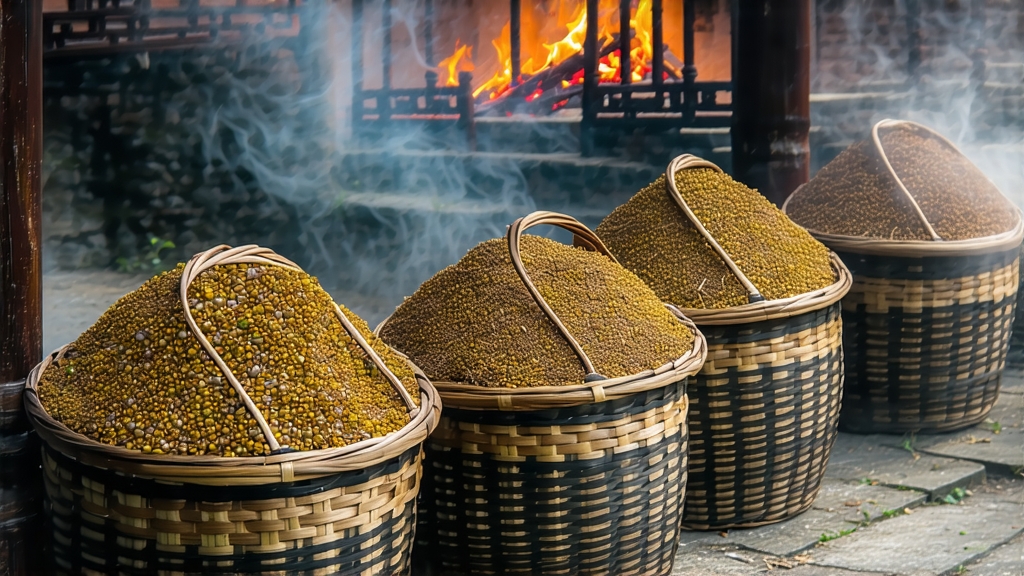
Tucked high in the mist-veiled Dabie Mountains of western Anhui Province, a tea once reserved for emperors still quietly resists the march of time. Huoshan Huangya—literally “Yellow Buds of Huoshan”—is the least-known yet most aristocratic member of China’s tiny yellow-tea family. While green tea commands global shelves and pu-erh fills investment vaults, Huoshan Huangya survives in a handful of stone villages where the air smells of pine charcoal and fresh bamboo. To meet it is to step into a living museum of Chinese taste, where color, aroma and etiquette were codified long before the word “tea” ever appeared in English.
A Brief, Almost-Secret History
The first written record dates to the Tang dynasty (618-907), when Lu Yu’s Classic of Tea praised the “golden springs and yellow shoots” of Huoshan county. By the Ming (1368-1644) the buds were steamed, pressed into cakes and sent south along the Yangtze as tribute. The Qing Qianlong Emperor (r. 1735-96), notorious for his connoisseurship, elevated Huoshan Huangya to the top of the imperial roster, awarding it the rare designation of “gongcha” (palace tea). Legend claims that only buds picked before the Qingming festival—while mountain apricots were still in blossom—were deemed sufficiently ethereal for the Son of Heaven. With the fall of the empire the tea drifted into obscurity; the 20th century’s wars and communes shrank production to fewer than twenty families. When China reopened in the 1980s, agronomists tracked down octogenarian masters who still remembered the “menhuang” sealing step, and a slow revival began. Today fewer than 300 mu (about 20 hectares) of heritage gardens are certified for authentic Huoshan Huangya, yielding roughly one ton a year—less than a single morning’s output at a modern green-tea factory.
Micro-Terroir: Why the Mountain Matters
Huoshan county straddles 31° N, the same latitude as India’s Darjeeling, but the Dabie range traps humid clouds that drop 1,800 mm of precipitation annually. Day-night temperature swings of 15 °C slow leaf metabolism, concentrating theanine and fragrant volatiles. Soils are yellow-brown loam derived from weathered granite, slightly acidic (pH 5.2) and laced with quartz that reflects sunlight back onto the undersides of leaves. The local cultivar, “Huoshan early bud,” is a landrace that breaks dormancy two weeks before the region’s standard tea bushes, yielding shoots so tender they can be plucked with the nail of the index finger—no twisting, no pull. Such gentleness prevents premature oxidation, a prerequisite for the yellowing that follows.
Three Grades, One Living Standard
Imperial tradition recognized only buds, but modern commerce differentiates three grades, all picked within a ten-day window:
- Special Grade (Tegji): single bud, 8–12 mm length, silvery down visible under oblique light.
- Grade One: bud with one just-opened leaf, the so-called “sparrow’s tongue.”
- Grade Two: bud with two leaves, reserved for domestic restaurants and for teaching demonstrations.
Each grade is processed identically; the difference is leaf material, not skill. Connoisseurs insist that Special Grade offers the purest expression of “yellow” both in cup color and in the soft, almost buttery texture that defines the genre.
The Craft: Seven Steps to Yellow
Yellow tea is often mis-described as “green tea with an extra pause.” In reality the menhuang (sealed yellowing) phase is a controlled microbial fermentation that oxidizes 10–15 % of the leaf’s catechins without ever reaching the redness of oolong. The full choreography, still performed on bamboo trays in open courtyards, is as follows:
- Plucking: 5 a.m.–8 a.m., shade-basket to prevent sunburn.
- Sha Qing (kill-green): 80 °C on a shallow iron wok for 90 seconds; the master listens for the “popcorn crackle” that signals complete de-enzyming.
- Initial Roll: light pressure to fracture cell walls; no juice should exude.
- First Bake: 60 °C charcoal embers for 20